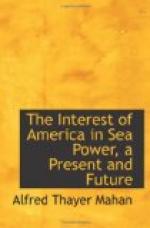In connection with this should be considered also the influence upon our mercantile and naval communication between the Atlantic and the Gulf coasts exercised by the peninsula of Florida, and by the narrowness of the channels separating the latter from the Bahama Banks and from Cuba. The effect of this long and not very broad strip of land upon our maritime interests can be realized best by imagining it wholly removed, or else turned into an island by a practicable channel crossing its neck. In the latter case the two entrances to the channel would have indeed to be assured; but our shipping would not be forced to pass through a long, narrow waterway, bordered throughout on one side by foreign and possibly hostile territories. In case of war with either Great Britain or Spain, this channel would be likely to be infested by hostile cruisers, close to their own base, the very best condition for a commerce-destroying war; and its protection by us under present circumstances will exact a much greater effort than with the supposed channel, or than if the Florida Peninsula did not exist. The effect of the peninsula is to thrust our route from the Atlantic to the Gulf 300 miles to the southward, and to make imperative a base for control of the strait; while the case is made worse by an almost total lack of useful harbors. On the Atlantic, the most exposed side, there is none; and on the Gulf none nearer to Key West than 175 miles,[2] where we find Tampa Bay. There is, indeed, nothing that can be said about the interests of the United States in an Isthmian canal that does not apply now with equal force to the Strait of Florida. The one links the Atlantic to the Gulf, as the other would the Atlantic to the Pacific. It may be added here that the phenomenon of the long, narrow peninsula of Florida, with its strait, is reproduced successively in Cuba, Haiti, and Puerto Rico, with the passages dividing them. The whole together forms one long barrier, the strategic significance of which cannot be overlooked in its effect upon the Caribbean; while the Gulf of Mexico is assigned to absolute seclusion by it, if the passages are in hostile control.
[2] There is Charlotte Harbor,
at 120 miles, but it can be used
only by medium-sized vessels.
The relations of the island of Jamaica to the great barrier formed by Cuba, Haiti, and Puerto Rico are such as to constitute it the natural stepping-stone by which to pass from the consideration of entrance into the Caribbean, which has been engaging our attention, to that of the transit across, from entrance to the Isthmus, which we must next undertake.




